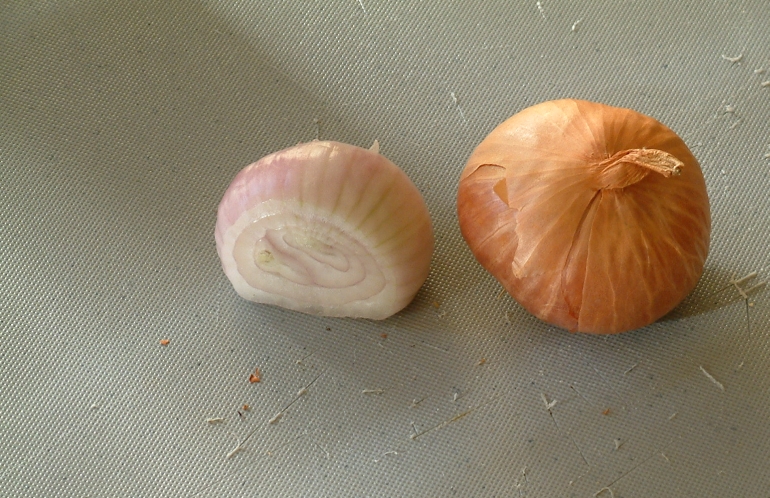- Shallot
Taxobox
name = Shallot

image_width = 250px
image_caption = Shallots
regnum =Plant ae
divisio = Magnoliophyta
classis =Liliopsida
ordo =Asparagales
familia =Alliaceae
genus = "Allium "
species = "A. oschaninii"
binomial = "Allium oschaninii"
binomial_authority = O. FedtschThe term shallot is used to describe two different "
Allium " species of plant. The French grey shallot or griselle, which has been considered to be the “true shallot” by many, is "Allium oschaninii", a species that grows wild from Central toSouthwest Asia . Other varieties of shallot are "Allium cepa" var. "aggregatum" (multiplieronion s), also known as "A. ascalonicum". Fact|date=August 2007This ambiguity is further confused with scallions, also known as spring or green onions. In some countries,
green onions are called shallots, and shallots are referred to by alternative names such as eschallot or eschalotte.The shallot is a relative of the onion, and tastes a bit like an onion but has a sweeter, milder flavor. They tend to be more expensive than onions, especially in the
United States , however they can be stored for at least 6 months. [http://www.ext.vt.edu/pubs/envirohort/426-411/426-411.html]Unlike onions where each plant normally forms a single bulb, shallots form clusters of
offsets , rather in the manner ofgarlic .Shallots are extensively cultivated and much used in cookery, in addition to being pickled. Finely sliced deep-fried shallots are used as a
condiment inAsian cuisine .Shallots are propagated by offsets, which, in the
Northern Hemisphere are often planted in September or October, but the principal crop should not be planted earlier than February or the beginning of March. In planting, the tops of the bulbs should be kept a little above ground, and it is a commendable plan to draw away thesoil surrounding the bulbs when their roots have taken hold. They should not be planted on ground recentlymanure d. They come to maturity about July or August, although they can now be found year-round in supermarkets.Similar to onions, raw shallots release chemicals that irritate the eye when sliced, resulting in tears. See
onion for a discussion of this phenomenon.Shallots appear to contain more
flavonoid s andphenols than other members of the onion family. [cite journal |author=Yang, J., Meyers, K.J., van der Heide, J. and Liu, R.H. |title=Varietal differences in phenolic content, and antioxidant and antiproliferative activities of onions |journal=J. Agric. Food Chem |volume=52 |issue=21 |pages=6787–6793 |year=2004 |pmid=15506817 |doi=10.1021/jf0307144]In Australia, the foodstuff industry has renamed a number of vegetables. The name "shallot" has been applied to scallions, normally called spring onions in Australia, and shallots have been renamed "eschalotte". The term "French shallot" has also been used for "Allium oschaninii".
There is a very specific region of shallot gardening in southeastern Ghana.
The name of the shallot derives from the name of the city of
Ashkelon (Latin ‘Ascalon’) in ancientCanaan , in Italian its name is "scalogno".hallots in Persian Cooking
The shallot in Persian is called موسیر (Moo-Seer), which is often crushed into yogurt. Iranians enjoy yogurt in this way, especially in restaurants and Kebbab-Saras where just kebabs are served. Most shallots are grown wild, harvested, sliced, dried, and sold at markets. Buyers will often soak the shallots for a number of days then boil them to get a milder flavor.
hallots in South East Asian Cooking
Shallots are called 'bawang merah kecil' (small red onions) in
Bahasa Melayu , an official language of Indonesia, Malaysia, Brunei, and Singapore,also called Brambang in Java, and "hom" (หอม - literally "fragrant") in Thai. In South East Asian cuisines, such as Thai, Malaysian and Indonesian cuisines, both shallots and garlic ('bawang putih', white onions) are very often used as elementary spices. Raw shallot can also accompany cucumbers when pickled in mild vinegar solution.It is also often chopped finely, then fried until golden brown, resulting in tiny crispy shallot chips called 'bawang goreng' (fried onions)in Indonesian language, which can be bought ready-made from groceries and supermarkets. It enhances the flavor of many South East Asian dishes, such asfried rice variants.In Indonesia, sometimes it is made intopickle which is usually added in variable kinds of traditional food. Its sourness increases one's appetite.It is widely used in the southern part of India. In Kannada language it is known as 'Eerulli' and used extensively in snacks, salads, curries and rice varieties. In Tamil it is called Sambar Vengayam and Kochulli in Malayalam and is used in Sambar (a type of curry) and different types of kuzhambu(curry).
References
Wikimedia Foundation. 2010.
